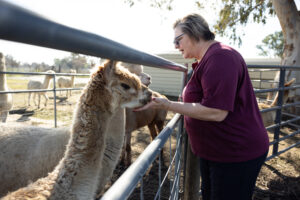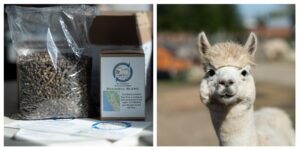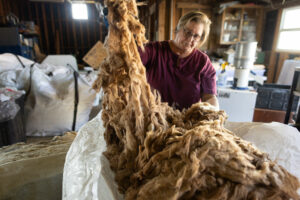Written by Stephany Wilkes. Photographed by Paige Green.

Two fiber business owners – Charlene Schmid of Integrity Alpacas & Fiber and Anna Hunter of Longway Homestead – create wool pellets to solve their wool-waste problems. In doing so, they’ve also created important regional infrastructure and systems that help other fiber producers.
Charlene is a farmer and certified wool classer with 30 alpacas in Vacaville, California. Her deep fiber knowledge led her “to be very picky about what fiber I use to put into the yarn, because it’s so expensive to process fiber. And I had a whole lot of fiber that I did not process.” Not all fleece and fiber is of sufficiently high quality to make it worth sending to a mill, Charlene says. “There are so many different grades of alpaca fiber, in the different places of a single fleece. You don’t want to blend them together, because the good stuff is washed out by the worst stuff.” Alpaca fiber also includes guard hair, a very straight fiber that doesn’t spin or play well with others.
To make use of waste fiber, Charlene made dryer balls, felted soaps, needle felting kits, and more. It required intensive labor. “It took a lot of time and a lot of water,” she says, “and I wasn’t making any money on it.”
Fiber mills produce waste, too. “We needed to come up with a better strategy for our mill waste,” Anna says. At Long Way Homestead Fibre Farm & Wool Mill, near Winnipeg, Manitoba, Canada, mill skirtings were piling up. “I was skirting hundreds of fleeces every week. We could not add more to our garden; I could not turn the compost by hand,” she explains. Anna tried to give mill skirtings away at events but had no takers.
When she walked into a greenhouse in Winnipeg, Anna saw wool pellets – made in the U.S.A. – on the shelf. “I thought, ‘Can I replace these with locally-made ones?’ It’s a product out there already,” she says. “I wouldn’t be starting from scratch. Maybe it was just instinct, but there are a significant number of knitters in my life who are also gardeners, who really love wool. I thought it would work, maybe make a little bit of extra revenue and we wouldn’t have to pay for mill waste to be handled.”
A Fertilizer Solution
Wool pellets are raw, low-quality wool or other fiber compressed into pellet form. They are a fertilizer or soil amendment, worked into the soil, with an application rate of approximately one half cup per gallon of soil. Since wool holds 30%-40% of its weight in water, pellets can help soil stay moist, and slugs avoid the tiny fibers that swell in water and stick out. Because fiber composts in soil, wool pellets need to be added to the soil periodically – every six months or so for ground use, or whenever plants are repotted.

Like Anna, Charlene wanted to make wool pellets. “But,” she says, “you couldn’t simply buy a machine and start making them.” Both women independently reached out to Elf Pellet Mills, a manufacturer of industrial pellet machinery based in the Czech Republic. But it was 2020, with Covid delaying or blocking many overseas imports. The machinery also required three-phase electrical power, which neither Charlene’s farm nor Anna’s mill has.
Then, both women found a video from Indiana-based Buskirk Engineering, of a man throwing wool into a pellet machine. “They weren’t doing anything to the wool beforehand,” Anna says. “Just throwing it into the hopper, if the fiber was shorter than five inches. We thought, ‘That’s just crazy enough to do,’ so we bought it.”
Charlene had seen the same video and inquired with Buskirk about a shredding machine. The video implied fiber shredding wasn’t required to make pellets, but Charlene had questions. “It was about the length of the fiber,” she says. “The pellet machine alone can’t handle longer fibers. They get tied up in the hammer and then you have to take it all apart. Alpaca has a lot of tensile strength, without the stiffness of something that breaks more easily,” like waste wood and sawdust that becomes wood pellets for stove fuel.
Buskirk Engineering had a prototype shredder, but said nobody would pay to develop it, so Charlene did. “The shredder piece was new to them. They had an idea of what they would make, but nobody was willing to fund the first one. So I did. The price was less than it would cost to buy an Elf. And we need machinery made here, so we do not have to rely on Europe for maintenance and training and all of those pieces. It was important to find a place in America or Canada that would do that.”
Manufacturing Wool Pellets
And so began Charlene’s research and development (R&D) journey with Buskirk Engineering. She established a relationship with the engineers, who found working with wool was different than shredding flax or wood. Finally, after 10 months, Charlene was allowed to come and visit – and refine the design.
“I took some Jacob wool and some alpaca,” she says. “I loaded up my suitcases with fleece and flew to Indiana.” A good thing, too, because the initial machine worked only with wool. Alpaca fiber is lighter in weight than wool, because alpaca does not have the heavy lanolin that wool does. “The alpaca fleece didn’t fall back into the cutters like wool did,” Charlene explains. “So we made modifications right there. It was, ‘Here, take this fiber, make that change.’ We also added a kill switch and a smaller motor.”

A shredder and pellet machine are now part of Charlene’s farm in Vacaville, California, a key piece of infrastructure. But developing and obtaining machinery was only the first hurdle of many. California regulations required Charlene to become a registered fertilizer, if she wanted to label her wool pellets as such. This meant education, certification, and navigating bureaucracy. The lab that tested fiber to obtain Charlene’s NPK numbers (nitrogen (N), phosphorus (P), and potassium (K), three macronutrients plants use) was itself not familiar with fiber. The state of California had a lot to say about labeling, on top of the consumer education, storytelling, packaging, and merchandising – getting onto store shelves – Charlene had to do.
Anna did not go through the process of becoming a certified fertilizer. “We sell a ‘soil amendment’,” she says.
Is manure included in wool pellets? No. Why not? Manure is a great fertilizer, right? Yes and no, Charlene explains. “Alpaca comes out about 2% higher than the wool, on nitrogen. The nitrogen levels that come from the fiber of the animal are higher than the poop. If I put manure in, I’m displacing a mass of nitrogen.”

And manure would mean a change in the die plate of the machinery, too. “A two-and-a-half-inch die plate created the best pellet for the blend,” Charlene says. “If I were going to add manure, I would need another, different die plate, which is several thousands of dollars. And I would have to change the die plate every time I was adding manure.”
Longway Homestead had only been making pellets for two months when Anna had people messaging her about them every day. “I was not prepared for how quick the response was,” she says, “or how fast we’d go through waste. We went through our mill waste in two weeks. We started paying one dollar per pound for bellies and necks, which was about four times more than people were getting at the co-op for their good-quality wool.”
Transforming Wool Waste through Sustainability
Anna’s approach is not only to build up her own business, but the regional and greater Canadian fiber community and wool industry as well. “I’m on the board of my local sheep association,” she says. “I was inundated with folks selling wool. And I thought, ‘I can keep this to myself, or I can blow this up and have pelleters across the country.’” She chose the latter, offering a workshop sharing her own research and what she’d done, and working with Fibershed. “There are now 11 pelleters running across Canada and three more at other stages of development.”
“The current hope is to replace all synthetic, municipal fertilizer with wool pellets within three years,” Anna adds. “I don’t know if it’s going to happen, but research has been done through the provincial ag department. City parks are not growing food; they are growing grass and marigolds. Those don’t require the precision of food crop fertilizers.”
In February, Integrity Alpacas & Fiber accepted the Honorable Mention Award for”Most Cooperative and Sustainable Innovation” at the Community Alliance with Family Farmers 2024 Small Farm Tech Expo. “The idea of wool pellets resonated with me as soon as I heard about it,” Charlene says. “I could make more yarn if I wanted to, but getting this into the earth is really, really important.”
